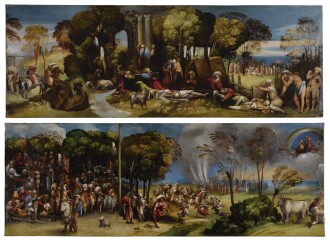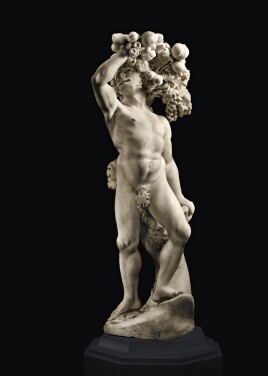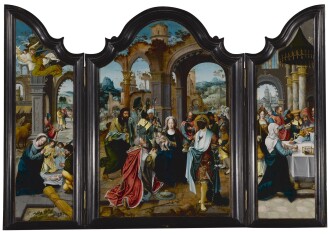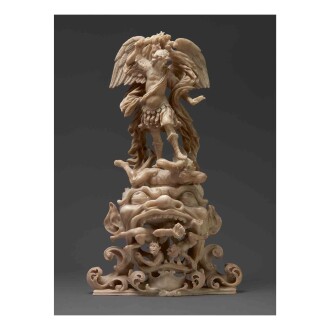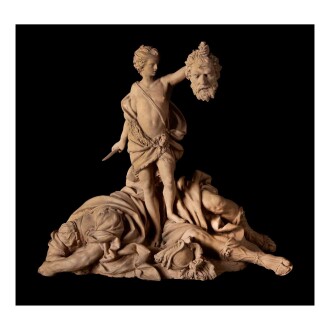D ynamic, unpredictable, and incomparable, Hester Diamond was a fearless and visionary collector. Whether through the expressive qualities of the paintings and sculpture in her apartment, the electric colors of her furniture, or in the mesmerizing patterns of the textiles she chose, each piece in her collection personifies Hester’s distinct vision and the freedom that came with being true to herself. The ability to pursue her passions with such conviction and clarity not only propelled Hester to build an extraordinary career as a venerated art dealer and interior designer, but, in a remarkable feat, to assemble important collections of both Modernist works and Old Master Paintings and Sculpture from the ground up that were of equal quality and breadth. Hester was a prolific and passionate collector and traveled extensively in search of quality. She acquired masterpieces by art historical titans such as Bernini and Dosso Dossi, but also recognized the beauty in the hands of anonymous masters, and the fresh viewpoints of contemporary voices like Barry X Ball and Bill Viola. The ease in which Hester displayed art and objects across time periods demonstrated the frivolity of artificial barriers imposed among collecting categories, and she proved that they could be broken and lived with comfortably.
Here, learn more about Hester Diamond's extraordinary life.
New York in the 1950’s
R ecently married, Hester and Harold began the 1950’s trying to reconcile their mutual love of art with the need to make a living. Hester began a secretarial job at Stair and Company, a leading antiques dealer on 57th Street, and Harold became a fourth-grade teacher. She quickly established herself at Stair and developed both a love of early English furniture and a keen eye for the material. Meanwhile, as they were making the rounds of the 57th Street galleries, Harold became friendly with Martha Jackson, the owner of an important gallery of cutting-edge contemporary art. Over time, Harold and Hester established themselves as part of that world. Around 1956, Harold was asked by a client to locate a particular Henry Moore. The assignment required securing three extra vacation days over the Thanksgiving holiday for a trip to Europe. When the school’s principal refused permission, Harold quit his $3,500 a year job and in lieu of the $5,000 commission on offer. His career as a full-time art dealer was launched and the couple’s life was never the same.

New Media, New Forms I, Martha Jackson Gallery, New York, 1962
When Harold and Hester were on a trip to England, they met Ben Nicholson and Barbara Hepworth, upcoming artists on the British scene. Ben’s work was reasonably well-known in America, but Barbara was still unknown. Hester and Harold proposed to organize a traveling exhibition of Barbara’s work, to introduce her to America. They packaged a show of small works and managed to convince about 10 small museums across the U.S. to present the show. The deal was simple: the participating museum got the show for free, but agreed to buy one piece out of the show for their permanent collection.
Auction Highlights
Interior Design Business
I n the early 1970’s, Harold’s largest clients were Seward and Basia Johnson, an heir to the Johnson & Johnson Company and his young wife, who had trained as an art historian. The Johnson’s became avid collectors of high-level modern painting and sculpture and found themselves in need of help managing and displaying their newly acquired treasures. Hester had always enjoyed decorating and offered to help. Hester’s particular focus was developing interiors which highlighted important works of art while simultaneously developing environments which held together aesthetically and were comfortable places to live. Hester designed and furnished two homes for the Johnson’s and soon found herself with a huge job and a going business. Hester found the time to take on other clients and eventually built her business into a good-sized and highly profitable venture, designing and decorating homes for a variety of serious collectors who needed help reconciling their desire to collect with their need to live their lives. Hester’s unique ability was to provide these clients with homes which were both showplaces for art and wonderful places to live; she also had an uncanny ability to mix and match art and furnishings of different nationalities, styles and dates. Hester continued in the decorating business for almost 30 years, eventually retiring from the active business of decorating other people’s homes in the late ‘80’s but continued to actively redecorate her own homes until the last year of her life.
Hester’s Personal Style
H ester’s personal taste and style were ever-evolving. Her crowning achievement was the Wallace Harrison house in Huntington, Long Island, which Harold and Hester convinced Harrison to sell to them, as they were prepared to bring it back to its former glory. Built as a modernist statement in the ‘30’s, Hester managed to return it to its art deco aesthetic while simultaneously updating it to 1970’s standards and making it a spectacular getaway house for her husband Harold and three children. The entire house was a remarkable accumulation of amazing objects. Hester’s personal style was similarly unusual. She had no interest in the latest dresses from the major designers, but instead had a closet full of remarkable clothes purchased from boutiques around the world, found on her travels, discovered at various craft fairs she would attend and purchased directly from a few designers whose work she admired.

Hester opened up and lightened the Harrison House in Huntington, LI – art deco fixtures were complimented by antique furniture and a huge Indian hanging silver bed. In the giant, circular living room, the 30-foot-long Leger mural (painted in situ by Leger in 1941; now in the Museum Ludwig, Cologne, Germany) was complemented by a large Frank Stella construction, an 18th Century Italian mosaic marble table, and a French 18th Century chaise.
Hester’s bright wardrobe was supplemented by an endless collection of handbags, gloves, eyeglasses, Swatch watches and other accessories, all assembled in outfits designed to suit the specific occasion.
Tributes to Hester Diamond from her family and close friends
Evolving Passions and Collecting
C ollecting is a gene. You either have it or you don’t and Hester had it many times over. Hester began collecting as a committed modernist, but her time working at Stair and Company led to a serious interest in English furniture. From relatively early on, throughout her homes, 18th Century English furniture was mixed in with more modern furniture and modern painting and sculpture. While many were surprised by the contrast, Hester instinctively knew how to make it work. Later, to fund her quest to begin collecting Old Masters, Hester sold a large Léger for a then record price of $11m and after that an important Cubist Picasso. Thus, began a decade long series of sales and acquisitions, with the original and new collections hung side by side throughout her large Central Park West apartment.
Sometime after Harold’s death in 1982, Hester wanted a new challenge and a new area to collect. She considered several fields, ultimately settling on Old Masters, specifically early Netherlandish and early Italian paintings. One day Hester realized that the number of Old Master paintings far outweighed the modern paintings; the visual mix no longer worked. In an uncharacteristic move, all the modern art was moved to the dining room. A few years later, she realized the modern art no longer had the same meaning to her - it was her old life, her old friends, her old interests. The next day she began the process of selling everything, with her usual speed and determination. Her then husband, Ralph Kaminsky, used to joke – “she got rid of everything except me, the Old Masters and the dog.” During this period, Hester also became interested in Old Master sculpture. As before, she sold paintings to fund her new passion, and eventually the three-dimensional works in her collection outnumbered the flat art.

After systematically replacing all of the modern art with old masters, she decided that there was not enough contrast with the classical furnishings, so she sold everything – furniture, dishes, glassware, etc. and replaced it with cutting-edge 21st Century design and a few select pieces of 21st Century sculpture. From that point on, eclecticism and dramatic contrasts were always part of the plan.
Hester and her first husband Harold were dealers in modern art and whenever possible, they would keep the best of what they were able to buy. Like any good dealer, no work was truly not for sale, but their personal collection, which hung on the walls of their apartment while Harold was alive and for many years later, included top examples by Pablo Picasso, Fernand Léger, a New York/Boogie Woogie by Piet Mondrian, Matisse, a 1912 Kandinsky, Braque, Matisse, Klee, Giacometti, Severini and Constantin Brancusi’s Bird in Space, 1926 (now Seattle Art Museum).
Hester had other serious – and less serious – collecting interests as well, including shells, antique boxes, Meister flowers, Wagner memorabilia, musical autographs of contemporary classical composers, Swatches and particularly mineral specimens. Each collection gave Hester joy, satisfied an intellectual curiosity, broadened her horizons and introduced her to new friends.

Hester’s collection of Wagner memorabilia and musical autographs (the latter two collections formed with Ralph and now in the collection of the Morgan Library, NY).
Awards presented to Michael Diamond of the Beastie Boys and gifted to his mother, Hester.
Over a decade, Hester’s collection of minerals was formed into an important collection of great depth, with items chosen based upon aesthetics rather than technical criteria and always for their sheer beauty.
Travel
H ester loved to travel, both to brand new places and to places (and people) she loved to revisit. She started seeing Europe in the late ‘40’s and early ‘50’s, as it was still recovering from the war, and eventually began the habit of spending the summer in Europe. After extensively covering Europe, her travel appetite continued to grow, and encompassed trips throughout the world, most often just a few years before places had “opened up” to Americans. All of her travels were focused on art – looking at ancient wonders, visiting all of the important museums and getting in touch with the local contemporary art scene. This habit continued after Hester’s marriage to her second husband, Ralph Kaminsky in 1985. Together and often with like-minded friends, they would travel to Europe several times a year, now to see art and also to hear Wagner and contemporary classical music concerts. They also visited more exotic locations and spent several years splitting their time between New York and Shanghai, which became both a second home for them and a base for deeper explorations into Asia. As late as 2018, Hester would travel to London or Rome for an important art opening or art fair, returning home 3-4 days later after also attending a continual stream of exhibitions, dinners and parties, and wondering aloud why she was so tired after such a short trip. Although she loved to travel, New York remained her home throughout her whole life.

Taking flight in Botswana
Hester with Ralph Kaminsky and stepdaughter, Rachel Kaminsky, traveling by snowmobile on the Vatnajokull glacier, Iceland.
Hester and Ralph Kaminsky in India
Traveling by donkey in Santorini
Hester in Shanghai
Hester and her son, Michael Diamond, at Victoria Falls
Continuing Conversations Through New Collaboration
F or Hester, people were more than just friends. They were a way to broaden her mind, expand her interests and to keep her young. She had friends of all ages, nationalities, professions and social-economic backgrounds. Her home was always open to individuals and groups, regardless of their supposed importance or status, who wanted to see her collections, talk about collecting or just meet her. When Hester’s stepdaughter, Rachel Kaminsky, became the Program Director for Artfully Dressed: Women in the Art World, by photographer Carla van de Puttelaar, Hester agreed to participate in the project. Prompted to comment on the industry by Carla’s project, Hester proclaimed:
“Women in the art business started to make their mark in Modern and Contemporary. I was right on time for that. They are barely beginning to be recognized in the world of Old Masters. It’s about time!”

Hester delighted in seeing her portrait photograph on display at Sotheby’s New York in January 2019 and meeting the other participants, some old friends, some new friends, and many much younger than her. She is pictured here at the exhibition with photographer, Carla van de Puttelaar, and her third husband David Wilson.
More Upcoming Auctions
Philanthropy
T hroughout her life, Hester was a committed and focused philanthropist. She was always ready to provide support for cultural and social service organizations whose missions she supported and whose programs she thought were effective. Later in life, she chose to focus on a few charities that were especially important to her. Hester was a driving force behind two significant charitable organizations. She was one of the founders of the Medici Archive Project, an organization designed to provide support to the huge repository of documents and other materials belonging to the Medici family in Florence. In 2013, along with her friends Jon Landau and Fabrizio Moretti, she founded VISTAS (Virtual Images of Sculpture in Time and Space), an organization committed to the ongoing publication of serious new scholarship on sculpture within the European tradition from 1200-1800 through the publication of books and the creation of related websites which use cutting edge tools to provide 3-D images of specific artworks.

With Hester’s help, the Medici Archive Project (and Johns Hopkins University) was able to digitize this resource and make it available to historians and art historians around the globe. Her interest in the archive with sparked by a newly discovered and reattributed Madonna and Child by Pontormo, which she acquired in 1992. When a Pontormo scholar was able to connect two archive numbers on the reverse of the panel to a detailed description of the painting in the Medici archive in Florence, the attribution and Hester’s interest in the project were sealed. More recently, Hester focused her attention on the decline in support for serious scholarship in early sculpture.
To date, VISTAS’ publications include The Sculpture of Tullio Lombardo by Anne Markham Schulz (2014), shortlisted for Best Book of the Year in 2015 by Apollo Magazine, and The Neptune Fountain in Bologna: Bronze, Marble and Water in the Making of a Papal City by Richard J. Tuttle (2015). Both the Medici Archive Project and VISTAS are continuing their efforts today.
